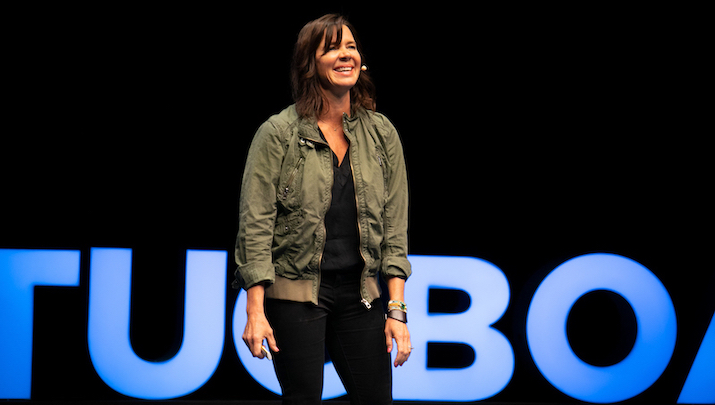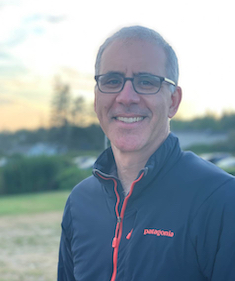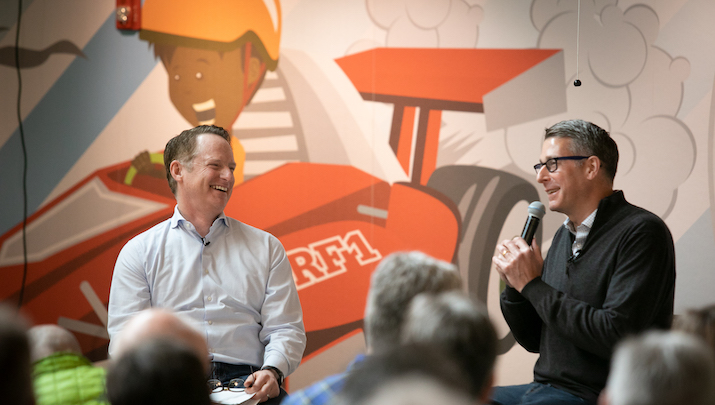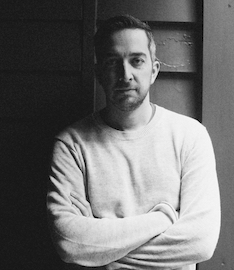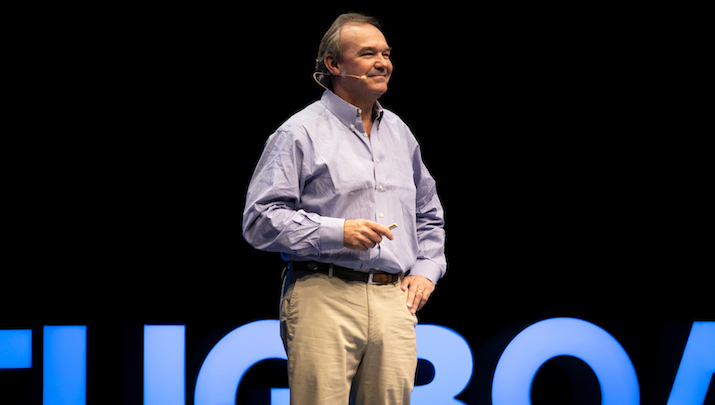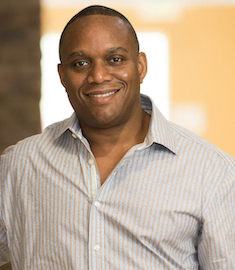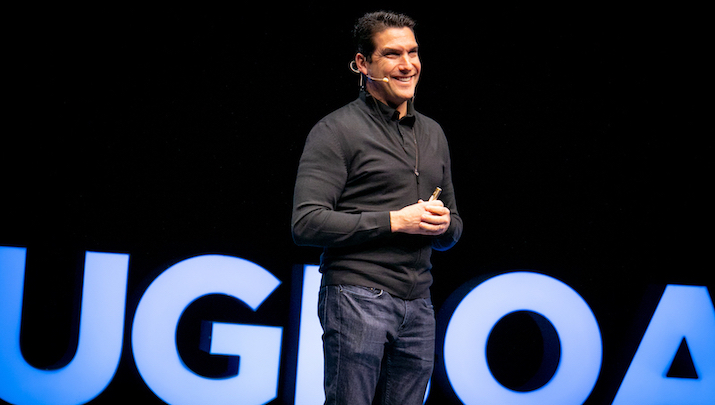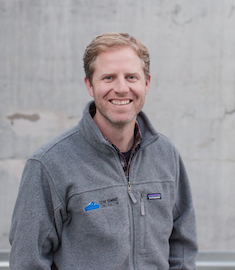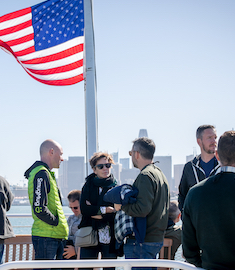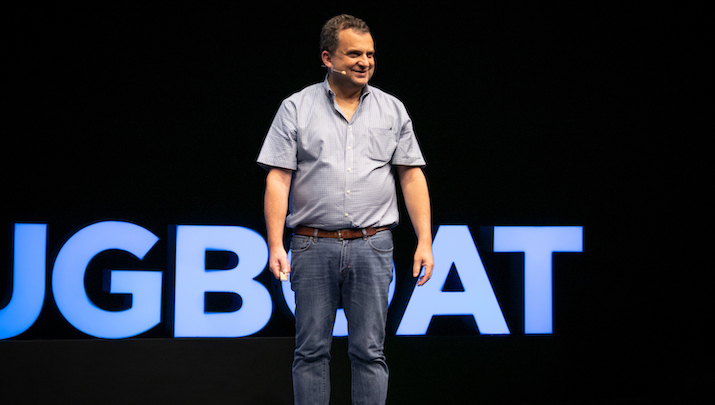Finding My Superpower
From the time she was a little girl, Mia Tate has loved stories. Her commitment to listening to and connecting with others’ experiences has inspired her work as an actor, writer, director, and producer. In fact, she has come to realize that the seemingly simple act of listening is a unique and valuable skill.
In this presentation from Tugboat Institute Summit 2019, Mia offers valuable perspective and inspiration for Evergreen leaders around the essential act of listening and shares the power of this skill to transform professional and personal connections.
Just Do It. Sit There.
As Evergreen leaders, I would guess that many of us set pretty high expectations for ourselves—in business and in our personal lives. I know I do – often to the point of being harder on myself than is productive. I am generally trying to get a lot done and, justified or not, I often feel like I need to do more just to keep up.
I was introduced to meditation in college by a happenstance flyer advertising a lecture by a visiting Japanese monk. I decided to give it a try. Since that time, I have found that meditation offers a way to practice pausing just a moment more before saying or doing the next thing. At my best, I can experience some of my thoughts and emotions without letting them immediately drive my actions. My goal is to meditate each workday, and the practice continues to help me find clarity and reduce stress.
While it may seem counterintuitive (meditation sounds like a something that happens very much in your head) the practice allows me to focus on acting and doing rather than ruminating. My practice is most informed by the Japanese Zen approach to mediation, which in my understanding is focused on paying attention to my breath and my body (rather than on a mantra or a visualization, for instance). I have found that this seemingly simple commitment to sitting for a few moments each morning before I go to work –just breathing in and out—is a ritual that positively informs my day.
As a side note, I don’t consider myself a Buddhist. I don’t find a conflict between this practice and my religious beliefs. Rather, I view it as a tool that enhances the way I approach life more generally, including my own religion.
In my personal practice, I sit first thing in the morning, before I look at my phone or do any type of work. While I would ideally sit for twenty minutes or more, often that is just not possible given the varied demands of a job and a family and perhaps a late wake-up or two. The commitment I’ve made to myself is that I will sit every workday for at least one minute. Often, I sit for more, but every day I know I can find at least sixty seconds. For me, this acts as a kind of placeholder, and it has helped me stay committed to the routine. Sitting on a meditation cushion, or some days just on the edge of the bed, I count my breaths, breathing evenly in and out ten times. Then I repeat. Most days I set a timer, some days it’s just 10 breaths (one minute) and I need to go. That’s it. It’s just sitting, breathing in and out, and doing my best to observe what's happening as I do that.
Many people think they are not good at meditation because their thoughts wander. The truth is, everyone’s thoughts wander—it’s just what thoughts do. The question is, when you notice that you are thinking about that upcoming meeting or the way you spoke to your employee yesterday, can you make the choice to let that thought rest, and bring your attention back to your breath or your body? Even if just for a moment. The thoughts will come again—they always do. It’s primarily a matter of returning when you notice.
While the focus on breath may seem a lesson in concentration and focus, the gift, for me, is the practice in letting the thoughts go. I think most of us operate in this almost ceaseless chain of thoughts and reaction, but if we can practice letting those thought-chains rest before we take action, perhaps that action can be more proactive and more intentional.
Though I’m not always aware when it happens, I know that this practice is translated into my workday. For instance, I may have an interaction with someone who says something that makes me feel an emotion and triggers a chain of thoughts, which, in turn, trigger a reaction. If I am able to observe and recognize that process and intentionally drop that chain of thoughts, I have created a bit of space to gain perspective. I can step back, for just a moment, and recognize the pattern. Instead of reacting, I can gain control of those thoughts. I can manage them instead of letting them manage me.
As a leader in my company, I think this ability to pause and take intentional action is a benefit. We can all get caught up in the frenetic pace of our roles—responding to emails and customers and internal issues—and can find ourselves surfing the wave of reactivity. To the extent that meditation can help me notice thoughts, sit with them, and avoid reacting, it can be a powerful tool. If someone comes into my office with a fire to put out, maybe I’m a little less likely to catch that fire. Instead of reacting right away to put it out, I might be able to wait a beat and then empower that person to put it out themselves. Note that this is not about sitting back and doing nothing. Rather, it’s about accessing the clarity to intentionally make effective decisions. I believe it allows for a more agile approach to the demands of business.
If you are interested in the science and psychology behind meditation from a Western point of view, I recommend Why Buddhism is True by Robert Wright. If you are interested in the Eastern, spiritual basis of this practice, I suggest Zen Mind Beginner Mind, by Shunryu Suzuki. Like many mind-body practices, meditation can be a tool to help you engage more effectively as a leader and provide you space for reflection. It’s not a panacea, but, in my life, the simple act of sitting still and breathing in and out continues to offer welcome benefit.
Ari Blum is President of Catalyst Real Estate.
Defining Moments in the Evergreen Story of Radio Flyer
In a Fireside Chat with Tugboat Institute Founder and CEO Dave Whorton, Robert Pasin, Chief Wagon Officer of Radio Flyer, notes his immense gratitude for the opportunity to continue to build the business his grandfather Antonio founded in 1917, led by his values. “My grandfather was defined by his commitment to integrity—both in the products he created and in his personal relationships—and by his magnanimous nature,” Robert says. It’s that approach to family, business, and community that have guided Robert through difficult periods in his and the company’s trajectory and continue to guide the Evergreen leader today.
One of the Best Restaurants in the World Puts People First
My grandfather, who founded Canlis, the 70-year-old fine-dining restaurant my brother and I now lead in Seattle, was known to wear a cape. And a lot of jewelry. He was an egomaniac who ran the restaurant much in the model of celebrity chefs that pop-culture has elevated today. He was a rabid perfectionist. He would have made for great reality television, our grandfather. Eccentricities and ego aside, his drive and innovations in fine dining built a restaurant that came to be recognized as one of the best in the world.
My parents, who took over the company in 1977, ran it with a different set of values. They cared less about ego and perfection and instead prioritized hospitality and family, community and philanthropy. They wanted everyone to feel welcome. Their approach guided the restaurant for 30 years, building on the reputation my grandfather established, garnering awards, and maintaining the restaurant’s place among the finest restaurants in the world.
It’s that restaurant that my brother, Mark, and I grew up in. It was a fine-dining, gorgeous restaurant that was all about people.
When my brother and I stepped in to lead Canlis in 2007, we did so against the backdrop of a rapid evolution in fine dining. Propelled by the advent and popularity of food television, chefs had become celebrities, and food and restaurant culture had become a pop culture phenomenon. Central to that culture was the image of the shouting, screaming, egotistical chef that my grandfather epitomized. The drama made for must-watch television, and the story that began to be told about fine dining kitchens was that they were toxic places of abuse, unfairness, and neglect. And the reality was, some great kitchens were run in this way. And often it was those great kitchens that got a lot of attention.
This was the landscape Mark and I entered as third-generation stewards of the family business. We knew that we needed to evolve the restaurant to compete in this new era of increasingly educated diners and elevated food culture, or we wouldn't survive. We had a decision to make: were we going to follow the model of other world-class restaurants that generally put product before culture, often fueling this negative, destructive culture that was being glorified? Or, were we going to try to be something else?
We had the benefit of the two models that came before us: our grandfather’s and our parents’. When we put our heads together, the question we asked was: "What if we could do both?" We didn't have a model for that among the world's great restaurants. We had not met a restaurant that shared our vision: to become one of the best restaurants in the world not in spite of caring for people but because we cared for people. We set out to forge the path.
Twelve years later, as we enter our seventieth year, we’re a happy anomaly. We are a thriving third-generation business, a restaurant that has defied the odds in longevity, and we believe the reason is our decision to take the best of both generations and create a new model for restaurant culture.
Our mission: To inspire all people to turn toward one another. That's an unusual mission statement for a fine dining restaurant. But we have lofty goals.
We want to help guide the industry, and in turn businesses across the country, to realize that caring about people is not a weakness. In fact, we believe that caring about people is a competitive advantage. That's the strategy we feel will allow us to become the best restaurant in America. And that's exciting for us because if we become the best, people will care about what we have to say. People will look to our model as they build their own businesses.
We have built several significant pillars to support our model, allowing us to bring together a value-aligned team, educate and empower that team to support our goal of being the best restaurant, and, ultimately, help transform restaurant culture.
Building a Value-Aligned Team
We ask people one question in our interview: “How will working at Canlis help you become who you want to become? Not what you want to become, but who.” The question surprises people. They're ready for us to grill them on their experience and their knowledge. But we believe the only person who really knows if this is the right job and if they will be the right fit for Canlis, is the person themselves. After the initial interview, we ask them to come work a shift at the restaurant, and they see how hard it is. After their shift, we sit down with them, and we say, "Now you know who we are. You've seen how it works. Are you the right person for the job?” We ask them to go home and talk to their partner or their kids or their parents, to consider if this job fits their vision for their life and to make a good decision. After that, only about 25 percent of applicants come back and say, “I want this job.”
The result: we build a phenomenal team of people with an aligned mission, direction, and purpose who really care about what we're doing. They understand the intensity of the work, and they still choose it and us.
Investing and Educating
We have 120 employees right now, and our hope is that every one of them leaves Canlis with a degree in running a business differently. All of our middle managers go through a year-long program we call Canlis University, designed to essentially offer a graduate degree in Canlis' management style. We teach them how to read a P&L, how to write a business plan, and how to create a mission statement—all tools they can use with us and in a future job.
Why invest in educating current employees for their next job? We know our employees are not going to stay here forever. We want to prepare them for the rest of their career. We know that if we do this, two things happen: first, when employees understand our investment in them today, they are inspired to give so much more; second, if and when they move on, they will bring our People First approach to the next restaurant they step into and help transform restaurant industry culture. It’s win-win.
Celebrating the Exit
When we hire an employee, we say, "We want to be a part of your exit.” People are often shocked by this. In the restaurant industry, there's a culture of betrayal if you leave and go work somewhere else, and there are a lot of burnt bridges as result. We think that’s unnecessary.
If Canlis is no longer the place that's helping a person become who he or she wants to be (again, who, not what), that person is no longer the right fit for our team. When that happens, we want to work together to find the perfect place for that person to land. We have an incredible network of connections in the industry, and we want to help deliver the employee to the next best place. We love the process of serving people in this way. And, when that person finds the next place, we throw a party to celebrate. We treat it like graduation day, and we hope he or she will carry the culture and lessons of their time with us forward.
What we’ve discovered as we’ve embraced this approach is that when we're investing in how people leave our restaurant they actually stay longer and they're more committed when they’re here. In addition, we’ve created an incredible alumni network of people who love our culture and believe in what we do. We are building bridges rather than burning them, and we are sharing that positive culture with the wider restaurant world.
The Big Picture
I sincerely believe that choosing to run Canlis the way we have, by putting People First, promotes longevity, provides a competitive advantage, and makes it a hell of a lot more fun to go to work in the morning.
On a larger scale, we believe the work we are doing in our own business can help improve our industry. There is a lot that’s broken in restaurant culture today. Food industry employees suffer from some of the highest rates of addiction, depression, and suicide. The irony is that we're supposed to be an industry that fills people up. The word restaurant comes from the Latin word for restoration. People come to our restaurants to be restored. And yet, we ourselves are the ones in most need of restoring as an industry. There's a sadness in that, and we want to help change that reality.
Ultimately, the magic of the dining room table is that it brings people together. It puts us across from one another, and it forces us to be eye-to-eye. There’s magic in breaking bread and drinking wine together and in what can happen relationally at a table. We all know how special that moment can be. We are grateful to play in some small part in turning people toward one another—at the table and in our business.
Brian Canlis is President and co-owner of Canlis.
Breaking Down the Walls
In 2009, Michael Kiolbassa was tired and on the verge of burnout. An early morning moment of spiritual surrender provided a personal and professional pivot point for the CEO and President of Kiolbassa Smoked Meats.
In this presentation from Tugboat Institute Summit 2019, Michael shares the story of the journey of transformation that followed that moment of release, as he embraced vulnerability and infused his company with Purpose.
Virtual (Assistant) Breakthrough
Toward the end of 2018, I hit a breaking point. Sales at our Evergreen® business, Life’s Abundance, were up about 20 percent over the previous year, and our profit was at an all-time high. But I was in big trouble.
Since joining the company in an IT role in 1999, I had consistently reinvented systems for managing my time as I took on new responsibilities and the demands on my time increased. I had done all the standard things to cope—I had delegated responsibilities; I had someone managing my calendar; I had a travel agent booking my travel; I had project managers handling many key initiatives in the company. Now, though, I found that I didn’t have any more tricks left up my sleeve to free up the time I needed to continue to manage the company in the way I knew I should into the future. Something had to give.
It was at this point that I had a conversation with a friend that changed everything. I had been describing to him that email was killing me. I had 900 emails in my inbox. I was drowning. His response: "You need a virtual assistant." He described the role to me—a professional who works remotely to deliver administrative support, handling a wide range of personal and work-related tasks online, including email management.
It hadn’t occurred to me that I might actually be at the point where I needed to hire someone to take over my email. That had always felt too sensitive, and I couldn’t imagine how someone else would be able to prioritize and filter for me. But I was ready to try anything.
So, inspired by desperation, I began to look into virtual assistant services. My search led me to a company that matches executives, exclusively, with virtual assistants. When I asked about email, they said, “of course we can manage that for you.” I was in—almost. First, I had to justify making the investment. I think, as business owners and leaders, sometimes the last person we invest in is ourselves. But, as I considered the other services that I was willing to spend money on, I realized this investment was as least as important.
I said yes to the possibility of time, and I entered into a matching process that included extensive interviews covering my management style, my personality type, and the scope of work required. I was informed that the assistant had also been thoroughly vetted—extensive background checks, professional references, and personality evaluations had already been conducted to ensure she was highly qualified and could be trusted to manage the most sensitive professional and personal information. The rigorous process resulted in a perfect match. I felt comfortable and aligned with my assistant, Jennifer, from the beginning.
I realized quickly how essential that sense of comfort and trust was because, once matched, the next step required a significant leap of faith. I had to provide my credit card numbers, my driver's license number, my social security number, my passport information, my global traveler information, and login information for all of the websites that she would need to access—and I had to provide the same for information for my wife and my son.
I know. It was scary. But the reality is that if I really wanted someone to manage tasks that were robbing me of valuable hours, I had to provide the tools for her to do that. I also gave her access to my personal and work email.
Over the next 30 days, working 20 hours per week, Jennifer reviewed all of my emails, and, through communication with me as she did so, was able to understand a lot about me and about the company to begin to filter and respond to mail. During days 31 to day 90, we focused in on more nuanced work style and preferences—she learned how much time I like between meetings and my communication style, among other topics. By the end of 90 days she was truly functioning as an extension of me: she was proactively managing my work and personal email and calendars, booking all travel, and managing personal projects like home repairs.
I realized just how much Jennifer had transformed my life during a work trip at about this time. Up to that point, getting on a plane meant I automatically turned to email with the goal of knocking out a few hours of work during the flight. This time, I turned on my computer and stopped: I had no email to respond to. It was like the first day of summer vacation: I felt like I should have homework to do, but instead I had free time. It was an incredible.
And while the email management is a huge piece of what makes this service so valuable, I think that the real differentiator in this investment is that because of her extensive experiences assisting C-level executives, Jennifer is qualified to be an extension of me. For instance, if I have a product idea and I want to research, what might take me one to two hours of online time just getting to the sources and filtering the background, I can turn that task over to Jennifer, who does the research and creates an executive summary that takes me five minutes to read.
My onsite assistant continues to provide me administrative support at our office—handling professional tasks that require an in-person presence onsite. The two positions complement one another and are clearly defined. This dynamic provides an important buffer between staff and sensitive information, protecting my onsite assistant from the burden of knowledge and ultimately having to be an island. A virtual assistant is entirely unencumbered by office politics.
As leaders of Evergreen companies, our time is the most important asset. Investing in someone who can help us optimize that asset just makes sense. If I had any doubt about the impact of hiring Jennifer, a recent conversation with my marketing director confirmed that I had made the right choice. She said to me, "I don't know if you realize this, Lester, but Jennifer has really been a game-changer for me. You have no idea what life was like the couple of months before she came on board. You were so overwhelmed, and we couldn't get stuff done. Now, I don't have to think about how I’m going to track you down if I need an answer because I get a response immediately from you or from Jennifer, and the company is able to move along a lot faster. We feel like we have our leader back."
Her comment hit home because I know she’s right: this gift of time and efficiency has also allowed me to lead again—to focus on larger, more strategic goals. As an example of this, I have a couple of new products that I had been wanting to launch for a couple of years, and I just couldn't find time to move these projects forward. I was actually able to hand the projects off to Jennifer and say, "Can you get this kick started for me?" Now we're going to have two new products come to market in the next six months that would have still been on the shelf if she wasn't around.
The benefit to my work life and my business continues to grow, but the fact that she handles both personal and professional projects is the real hack—the thing that buys the time back. Being able to off-load personal tasks has allowed me spend time on what matters—at home and at work. If I spend two hours communicating with a power-washing service to take care of my roof, that’s two hours I don’t have to focus on my business or spend quality time with my family. There is no reason for me to be devoting time to that task, which someone else can handle from start to finish. And our lives are filled with tasks like that, tedious but necessary.
At the end of the day, the biggest benefit to me is that I feel re-energized and unburdened. I didn't realize how much pressure I was under until some of that stuff was lifted off of me. I am able to be a lot more visionary. I don't get bogged down with stuff like I used to, and nothing falls through the cracks. My team has their leader back.
Lester Thornhill is CEO of Life’s Abundance.
Bread, Butterflies, and Boats: Business and the Signs of the Universe
Everyone deserves to enjoy delicious, high-quality food in a beautiful setting. At 12 locations in Los Angeles, La Monarca Bakery offers just that—notably in largely Latino neighborhoods often overlooked by investors and business owners.
In this presentation from Tugboat Institute Summit 2019, Ricardo Cervantes describes how he and his partner, Alfredo Livas, have committed to delivering a new customer and employee experience in the communities in which La Monarca Bakery operates and their broader dedication to making the world a better place through conservation efforts.
Constructing a Foundation of Trust
The foundation of our Evergreen® company, cookline, is trust. It is the most essential ingredient in our success, and the thing that sets us apart in our industry. We are general contractors devoted solely to building restaurants in the San Francisco area, working with restaurateurs to create high-quality, beautiful spaces that reflect their vision and provide the greatest opportunity for success in a notoriously tough industry and city.
An unconventional upbringing and path brought me here. In 1971, my parents joined a group of about 300 like-minded people living in San Francisco who had a dream of living off the land and building a community on shared values of non-violence and respect for the environment. I was born on a commune in Tennessee and lived there until I reversed my parents’ steps and moved West to California after I graduated from high school.
The pillars of the commune were trust and food—we lived sustainably on the land, growing our own food and trading with local farmers for other goods. Nobody used money. The success of the community was completely dependent on members helping one another.
Many of my most vibrant childhood memories revolve around food—eating my mother’s bread fresh from the oven after school, hours spent cleaning and preserving strawberries received in trade from our Amish neighbors, learning to cook and making meals for friends and family.
I absorbed and embraced a respect for and joy in food and in the community that sharing food creates.
This early connection to food and community led me to restaurant work in California at age 19. Over the next 10 years, I worked my way up through the ranks of restaurant management, beginning with an entry-level kitchen position at San Francisco’s iconic Boulevard and ultimately serving as project manager for bakery chain La Boulangerie, as that business expanded rapidly throughout the Bay Area.
Those years taught me many lessons in Perseverance and essential management skills. I was fueled through those often-grueling days by my love for the tight-knit restaurant community in San Francisco. Here was a community—like the one that had raised me—that was focused on food, trust, and perseverance, and where people helped one another and supported each other’s businesses and their neighborhoods. Finding my place in that community was a homecoming.
From my early years in the restaurant industry, I had a clear sense that I wanted to have my own business. At first, my dream was to open a restaurant, but when I was appointed Project Manager at La Boulangerie and worked closely with the general contractor hired to build out new locations, I saw the opportunity for a different path.
Observing the manner in which the contractor conducted business with his clients—all restaurants—revealed a disturbing lack of trust and transparency in those relationships. I was blatantly lied to during my time managing the La Boulangerie project, and the lack of customer service generally was non-existent. The contractor’s single priority was his bottom line, and the customer’s needs and budget were often ignored. Change order fees were huge, and job costs were routinely 20-30 percent higher than the initial bid. There was a complete lack of understanding of the razor-thin margins with which restaurants operate and the precarious financial position of these businesses in such a competitive market.
I knew then that I could create a different, better model of a general contracting business that would serve the unique needs of the restaurant community. I knew that restaurants count pennies to make it, and the failure rate is staggeringly high. I wanted restaurateurs to have every opportunity for success, and I wanted the unique trust that exists within the San Francisco restaurateur community to extend to the contractor charged with building their businesses. I wanted to create a new relationship model. This was something that I could do—and do well.
With this goal in mind, I spent two years working for a general contractor to learn as much as I could about the construction field. In those two years I further experienced the frustration and the financial cost of this ongoing misalignment and tension between contractor and restaurateur. I also observed the fact that the contractor I was working for, a man who was building a company around the restaurant construction, did not actually eat at the restaurants he built. He didn’t support the community from which he made his living.
In 2014, I co-founded cookline to offer a different approach, to serve the restaurant community I love so much and understand well. I wanted to not only help the restaurateurs create the spaces they envisioned, but I was also committed to establishing relationships built on trust and integrating myself into the community of clients I served.
Today, we focus every day on being transparent and honest with our clients—and saving them money—while delivering quality workmanship. We strive to value engineer and follow through to the end to create a positive relationship with the client. We watch out for our clients’ bottom lines by collaborating with designers and subcontractors throughout the construction process, seeking out lower- cost alternate materials, suggesting design changes that will be less expensive, and always focusing on the schedule to find efficiencies. The result of this hyper-focus on client experience and cost has allowed us to give money back to every single client.
Through these commitments, we have developed trust in an industry more commonly committed to their own profit. When our clients open a new restaurant feeling great about the space and without an undue financial burden, we hope we are offering them the best opportunity for success. That matters to us.
But our commitment to the restaurant community goes a bit further. Our engagement with the restaurants we build does not end when we hand over the keys to the space. We eat at our clients’ establishments; we purchase gift certificates for our employees so that they can also dine at the businesses they help bring to life; our weekly company happy hours are catered by our clients. I’ve attended a client’s wedding and have developed meaningful, lasting friendships with people who were my clients first.
In my mind, as I dreamt of creating a business in the restaurant industry, the goal was always to make a difference in the tight-knit community that I loved. Now, as I strive to transform the relationships and services in our niche of restaurant construction, I feel I’m doing just that. Our clients feed our community, and we are able to help them deliver that magic of a shared meal, and hopefully given them a better chance of long-term success based upon our quality work.
I wouldn’t be where I am today had my path not started where it did or travelled the unconventional route it took. I feel that I have now come full circle—from my childhood on the commune, where trust and food were the focus of our lives, I am now building restaurants that are the heart of their communities.
Levi Hunt is Co-Founder of cookline.
Evergreen Businesses are Thriving in Silicon Valley
Dave Whorton, CEO of Tugboat Institute®, spent his early career as co-founder of three technology companies and as an investor at one of the leading venture capital firms in Silicon Valley—the very firm, in fact, that birthed the get-big-fast approach that now defines Silicon Valley’s playbook.
In 2013, Dave began a learning journey, seeking out iconoclasts who were leading private, Purpose-driven, growing companies built for the long-term—with no plan to sell. The conversations he had over the next year with more than forty of those iconoclasts transformed his thinking and led to the founding of Tugboat Institute to serve these leaders.
Last week, roughly six years after Dave’s journey began, 75 Tugboat Institute members gathered in California for the Tugboat Institute @SiliconValley experience, coming together to learn, share, and connect around their commitment to building successful Evergreen® companies. Hosted by four early Tugboat Institute members currently leading Evergreen businesses in Silicon Valley, this Tugboat Institute Exemplar Visit delivered.
The experience began at Levi’s Stadium, home to the San Francisco 49ers. Located in Santa Clara, the stadium sits in the heart of Silicon Valley, but Jed York, CEO of the 49ers, leads the family-owned business with deep alignment to the Evergreen 7Ps™. A member of Tugboat Institute since 2013, Jed greeted his fellow members via a heartfelt welcome video, commending the leaders gathered on his home turf for their commitment to the Evergreen movement. He then introduced key members of his management team, who then offered attendees a rare glimpse into the inner workings of this storied franchise (which happens to have a record of 6-0 this season!).
The evening’s programming covered topics ranging from players’ experiences to the strategy of the front office to the team’s community engagement. Four-time Super Bowl player and current Vice President and Senior Advisor to the General Manager, Keena Taylor, shared his perspective through a fireside chat with Dave, followed by insight into the 49ers’ commitment to their community, delivered by Hannah Gordon, Chief Administrative Officer and General Council. Brent Schoeb, Chief Revenue Officer, provided a deep dive into the business of football, and Moon Javaid, VP Strategy and Analytics, offered a fascinating look at the technology utilized to improve the 49ers’ customer experience. A stadium tour and a dinner gathering in the Citrix Owner’s club rounded out the evening.
On Wednesday morning, members traveled to Redwood City to learn from Tugboat members Mac Harman and Don MacAskill. Mac’s company, Balsam Hill, launched in the tradition of many a Silicon Valley startup—in student housing on the Stanford University campus, where Mac attended Stanford’s Graduate School of Business—but the Evergreen journey that followed saw his ecommerce company take a wildly divergent path from the Silicon Valley norm. As an online retailer of artificial Christmas trees, Balsam Hill’s products are literally “evergreen,” and it was clear, as members heard from executive team members, including Caroline Tuan, COO, Kristin Gasior, CMO, and Claire Magat, EVP of People, that the company is deeply committed to Evergreen principles. Through authentic stories of defining moments that included challenges as well as successes, gaps as well as triumphant leaps, the Balsam Hill team offered the audience an overview of an inspiring, market-leading, Evergreen business.
Following a tour of Balsam Hill headquarters and lunch, Don MacAskill introduced his company, SmugMug, and described his unique position as a Founder and CEO in the Bay Area: “I founded and continue to lead a bootstrapped, family-run technology company in Silicon Valley. I’m pretty sure we’re the only company that meets that description around here.” Don went on to describe the continual innovation that defines the business—the first online, subscription-based internet business—driven by the company’s laser focus on serving photographers with exceptional products and customer service. From the early days and through the company’s recent acquisition of Flickr from Yahoo/Verizon, the company has tuned into the voices of their customers to cut through the noise of Silicon Valley’s technology hype and the ongoing stream of VC-backed photo startups to grow a large, loved, Purpose-driven company for the long-term.
Thursday’s itinerary brought members out of Silicon Valley and into San Francisco to learn from an Evergreen business that leads from the heart to nourish their community. The Bi-Rite Family of Businesses, led by Tugboat Institute member Calvin Tsay and his partner, Sam Mogannam, includes two Bi-Rite markets, the Bi-Rite Creamery, a catering business, a café, and 18 Reasons, a nonprofit community cooking school. Sam and Calvin shared the rich history and Purpose-fueled journey of their business, sharing their love for food with the Tugboat audience through stories and food. Calvin reminded the group that, “You can’t build relationships and connection through a four-inch screen.”
That afternoon, members explored the city on gorgeous bluebird day, with a walk along Chrissy Field for some and a tour of Alcatraz for others. Thursday evening’s celebration brought the community together at SmugMug headquarters in Mountain View. There, surrounded by stunning photographs that reflect the MacAskills’ passion for photography, members shared a meal catered by the SmugMug chef and enjoyed Obsidian Ridge wines contributed by member Arpad Molnar, oysters contributed by member John Finger’s Hog Island Oyster Co., and a tequila tasting hosted by Arturo Lomeli and Juan Sanchez, Tugboat members and owners of Tequila Clase Azul. The evening was a perfect finale, filled with gratitude and promises of maintained connections among members who headed home with a renewed commitment to the Evergreen path.
While many members traveled home on Friday morning, about 15 remained in Silicon Valley to attend a Stanford University Center for Entrepreneurial Studies symposium, “Entrepreneurship: Long-Term Organic Growth,” which featured panels made up of Tugboat Institute members, moderated by Dave Whorton and Tugboat Institute Fellow Spencer Burke. Attended by over 100 Stanford University alumni and students, the panels and discussion that followed reflected the rising interest and engagement around alternatives to our society’s current definition of business success—one that is too focused on venture capital’s playbook, raising cash over generating cash, and big exits. It was exciting to hear the enthusiasm expressed by the audience for Evergreen businesses and principles—an energizing and affirming finish to the inspiring week.
Diana Price is Content Manager at Tugboat Institute.
Demystifying Debt Growth Capital
How would you finance an acquisition? Deplete your cash flow? Take out a bank loan? Ignore the opportunity to avoid risk? In this 5-minute presentation from Tugboat Institute Summit 2019, Ami Kassar, founder and CEO of MultiFunding LLC, and author of The Growth Dilemma, presents another—less well-known—option for funding growth.
